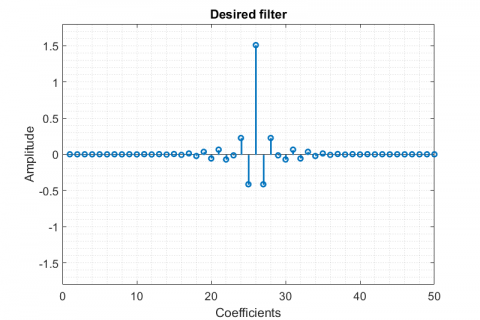/*
Filter a signal containing two frequencies using the overlap-save method.
Uses CMSIS Version 5.3.0 f32 routines on a Teensy 3.6
*/
// Common libraries:
#include <arm_math.h>
#include <arm_const_structs.h>
//#include <ref.h>
#define bufSize 8192
#define numpts 512
#define impulse_length_minus_1 199
static arm_status status;
static arm_rfft_fast_instance_f32 fft_instance;
boolean out_pin; // Use for timing
float32_t input_waveform[bufSize];
float32_t output_waveform[bufSize];
float32_t fft_aray[numpts]; // Array used to store fft result
float32_t window[numpts]; // Array used to store fft of filter data
float32_t cmplx_product[numpts]; // Array used to store complex product of fft result and window
float32_t Ak[numpts]; // Used to store data being sent to the fft routines
float32_t fft_result[numpts]; // Output from inverse fft
float32_t filter[numpts]; // Will contain the impulse that is terminated with zero padding
float32_t impulse[impulse_length_minus_1 + 1] = { // Impulse response for low-pass filter beginning at frequency bin 20 out of 128. Stop band > -100 dB
9.4978700E-08, -1.0099240E-06, -3.9555098E-06, -8.1674212E-06, -1.2233856E-05, -1.4147944E-05, -1.1836013E-05, -3.8747080E-06,
9.7844092E-06, 2.7311901E-05, 4.4937360E-05, 5.7465704E-05, 5.9374463E-05, 4.6323969E-05, 1.6752608E-05, -2.6873229E-05,
-7.7589710E-05, -1.2456752E-04, -1.5493964E-04, -1.5661931E-04, -1.2159463E-04, -4.8950325E-05, 5.3220769E-05, 1.6774265E-04,
2.7052492E-04, 3.3489880E-04, 3.3748708E-04, 2.6447337E-04, 1.1682254E-04, -8.7008106E-05, -3.1198579E-04, -5.1149393E-04,
-6.3594928E-04, -6.4365675E-04, -5.1175053E-04, -2.4469101E-04, 1.2205630E-04, 5.2479704E-04, 8.8124334E-04, 1.1058973E-03,
1.1285844E-03, 9.1242952E-04, 4.6714264E-04, -1.4606171E-04, -8.2023298E-04, -1.4193952E-03, -1.8040441E-03, -1.8610211E-03,
-1.5317851E-03, -8.3265360E-04, 1.3849318E-04, 1.2123019E-03, 2.1748259E-03, 2.8075305E-03, 2.9334421E-03, 2.4602629E-03,
1.4107964E-03, -6.7401987E-05, -1.7177495E-03, -3.2154444E-03, -4.2276791E-03, -4.4827877E-03, -3.8347517E-03, -2.3089211E-03,
-1.1716140E-04, 2.3642611E-03, 4.6536868E-03, 6.2518534E-03, 6.7434843E-03, 5.8931952E-03, 3.7152958E-03, 5.0023185E-04,
-3.2125723E-03, -6.7158793E-03, -9.2593249E-03, -1.0197256E-02, -9.1325789E-03, -6.0274401E-03, -1.2551129E-03, 4.4236323E-03,
9.9633829E-03, 1.4204956E-02, 1.6088985E-02, 1.4876395E-02, 1.0335310E-02, 2.8564602E-03, -6.5310283E-03, -1.6255904E-02,
-2.4406433E-02, -2.9011491E-02, -2.8359337E-02, -2.1302867E-02, -7.4992025E-03, 1.2460427E-02, 3.7058422E-02, 6.4002438E-02,
9.0503604E-02, 1.1364256E-01, 1.3076897E-01, 1.3987339E-01, 1.3987339E-01, 1.3076897E-01, 1.1364256E-01, 9.0503604E-02,
6.4002438E-02, 3.7058422E-02, 1.2460427E-02, -7.4992025E-03, -2.1302867E-02, -2.8359337E-02, -2.9011491E-02, -2.4406433E-02,
-1.6255904E-02, -6.5310283E-03, 2.8564602E-03, 1.0335310E-02, 1.4876395E-02, 1.6088985E-02, 1.4204956E-02, 9.9633829E-03,
4.4236323E-03, -1.2551129E-03, -6.0274401E-03, -9.1325789E-03, -1.0197256E-02, -9.2593249E-03, -6.7158793E-03, -3.2125723E-03,
5.0023185E-04, 3.7152958E-03, 5.8931952E-03, 6.7434843E-03, 6.2518534E-03, 4.6536868E-03, 2.3642611E-03, -1.1716140E-04,
-2.3089211E-03, -3.8347517E-03, -4.4827877E-03, -4.2276791E-03, -3.2154444E-03, -1.7177495E-03, -6.7401987E-05, 1.4107964E-03,
2.4602629E-03, 2.9334421E-03, 2.8075305E-03, 2.1748259E-03, 1.2123019E-03, 1.3849318E-04, -8.3265360E-04, -1.5317851E-03,
-1.8610211E-03, -1.8040441E-03, -1.4193952E-03, -8.2023298E-04, -1.4606171E-04, 4.6714264E-04, 9.1242952E-04, 1.1285844E-03,
1.1058973E-03, 8.8124334E-04, 5.2479704E-04, 1.2205630E-04, -2.4469101E-04, -5.1175053E-04, -6.4365675E-04, -6.3594928E-04,
-5.1149393E-04, -3.1198579E-04, -8.7008106E-05, 1.1682254E-04, 2.6447337E-04, 3.3748708E-04, 3.3489880E-04, 2.7052492E-04,
1.6774265E-04, 5.3220769E-05, -4.8950325E-05, -1.2159463E-04, -1.5661931E-04, -1.5493964E-04, -1.2456752E-04, -7.7589710E-05,
-2.6873229E-05, 1.6752608E-05, 4.6323969E-05, 5.9374463E-05, 5.7465704E-05, 4.4937360E-05, 2.7311901E-05, 9.7844092E-06,
-3.8747080E-06, -1.1836013E-05, -1.4147944E-05, -1.2233856E-05, -8.1674212E-06, -3.9555098E-06, -1.0099240E-06, 9.4978700E-08
};
float pi = 3.1415926535897932f;
float freq1; // Want to keep freq1
float freq2; // Want to filter out freq2
void setup()
{
Serial.begin (230400);
// Set up output ports for timing purposes
PORTC_PCR4 = ( unsigned long ) 0x00000101; // Section 12.5.1, pg. 221 - 222, see Pin Mux Control
// Bit 0 -> Pull Select -> Internal pullup resistor is enabled
// Bit 8 -> ALT1 -> GPIO
PORTC_PCR5 = ( unsigned long ) 0x00000101; // Section 12.5.1, pg. 221 - 222, see Pin Mux Control
// Bit 0 -> Pull Select -> Internal pullup resistor is enabled
// Bit 8 -> ALT1 -> GPIO
GPIOC_PDDR = ( unsigned long ) 0x00000020; // Configure pin 13 as output. See Section 63.3.6. Pin 13 is PTC5 (on-board LED)
// Build waveform for processing
freq1 = 5. * (float)numpts/(float)(impulse_length_minus_1 + 1); //Want to keep freq1
freq2 = 4. * freq1; //Want to filter out freq2. For a 256 point FFT the 3 dB cutoff frequency is at about frequency bin #19
for (int i=0; i < (bufSize); i ++) // Calculate signal to filter over bufSize points
{
input_waveform[i] = sin(2. * pi * freq1 * (float)i/(float)numpts) + sin(2. * pi * freq2 * (float)i/(float)numpts);
}
// Build impulse filter array. Need to zero pad from the end of the impulse to numpts (end of the array).
arm_fill_f32(0.0, filter, numpts);
for (int i = 0; i < impulse_length_minus_1 + 1; i++) filter[i] = impulse[i];
status = arm_rfft_fast_init_f32(&fft_instance, numpts); // Initialize the fft routines
arm_rfft_fast_f32(&fft_instance, filter, window, 0); // Calculate the spectral response of the filter.
GPIOC_PSOR |= (1 << 5); // Section 63.3.2 - Set pin 13 HIGH
out_pin = true;
delay(5000); // Give plenty of time to trigger scope and to select either the Serial Monitor or Serial Plotter
}
void loop()
{
arm_fill_f32(0.0, output_waveform, bufSize);
arm_fill_f32(0.0, input_waveform, impulse_length_minus_1); //Need to zero pad the beginning of the signal so the circular convolution matches a linear convolution.
// This loop for processing input_waveform data completes in about 500 microseconds per pass for numpts = 512
// 900 microseconds per pass for numpts = 1024
for (int i = 0; i < bufSize/(numpts - impulse_length_minus_1); i++) { // Use for overlap to avoid circular convolution
if (out_pin) GPIOC_PCOR |= (1 << 5); // Section 63.3.1 - Set pin 13 LOW -- Use for scope timing
else
GPIOC_PSOR |= (1 << 5); // Section 63.3.2 - Set pin 13 HIGH
out_pin = !out_pin;
arm_copy_f32(input_waveform + i * (numpts - impulse_length_minus_1), Ak, numpts);
arm_rfft_fast_f32(&fft_instance, Ak, fft_aray, 0);
arm_cmplx_mult_cmplx_f32(fft_aray, window, cmplx_product, numpts/2); // Multiplication in frequency domain is a convolution in the time domain
arm_rfft_fast_f32(&fft_instance, cmplx_product, fft_result, 1); // Inverse transform
arm_copy_f32(fft_result + impulse_length_minus_1, output_waveform + i * (numpts - impulse_length_minus_1), numpts - impulse_length_minus_1);
}
for (int i = 0; i < 1000; i++) Serial.println(output_waveform[i]); //Use to drive the serial plotter to display the second set of 500 points
while(1) {}
}



